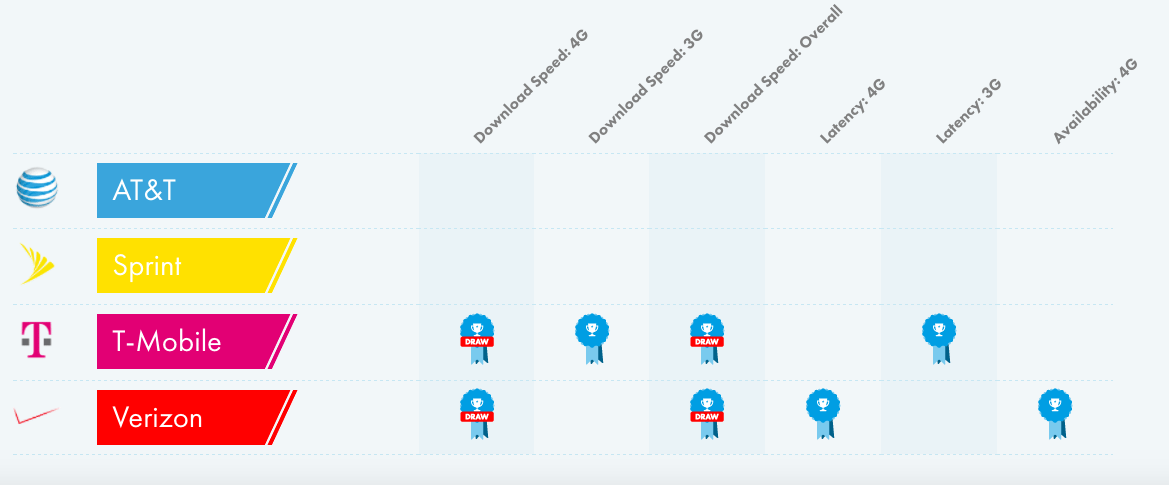Verizon and T-Mobile were in a statistical dead heat in terms of LTE speeds, with T-Mobile closing the gap on Verizon in terms of LTE coverage.
The battle for domestic wireless network supremacy continues to be waged between Verizon Wireless and T-Mobile US, according to the latest network testing results from OpenSignal.
In OpenSignal’s latest round of testing, which was conducted during the second half of last year via the firms downloadable smartphone application, Verizon Wireless managed to make up some ground on T-Mobile US in terms of overall network speeds, while T-Mobile US inched closer to its larger rival in terms of LTE availability.
OpenSignal’s testing found a near statistical tie between Verizon Wireless and T-Mobile US in terms of average LTE download speeds, with both carriers coming in at just below 17 megabits per second. However, when taking into account 3G network performance, T-Mobile US pulled ahead with its HSPA-based network scoring 4 Mbps in average download speeds compared with just 850 kilobits per second from Verizon Wireless’ CDMA2000 1x EV-DO 3G network.

Verizon Wireless was a close second to T-Mobile US in OpenSignal’s previous LTE network speed tests conducted during the first half of 2016, with the former posting average download speeds of 15.94 Mbps compared with the latter’s 16.28 Mbps.
OpenSignal cited Verizon Wireless’ move last year in launching its LTE Advanced services, which the carrier said would boost network speeds by up to 50%.
“While OpenSignal tracks average speeds, not peak speeds, we definitely see evidence of Verizon’s upgrades showing up in our metrics,” the firm noted. “In addition to our measured uptick in national 4G speeds, we recorded big increases for Verizon in several of the markets in our U.S. city breakdown.”
AT&T Mobility came in at No. 3 in terms of LTE network speeds in the latest test, with the carrier posting an average download speed of 13.86 Mbps, while its HSPA-based 3G network was No. 2 with a speed of 3.04 Mbps. Sprint was a distant No. 4 in LTE network speed at 8.99 Mbps and just slightly ahead of Verizon Wireless in 3G network speeds at 970 kbps.
AT&T Mobility managed to improve its LTE network speed performance compared with the previous test where it managed an average download speed of 12.83 Mbps, while Sprint witnessed its speed performance drop from 9.36 Mbps in the previous test.
In terms of what OpenSignal calls “network availability,” Verizon Wireless again came out on top of the reports LTE rankings with the application showing LTE network availability at 88.17%. T-Mobile US was a close second at 86.6%, followed by AT&T Mobility at 82.23% and Sprint a distant No. 4 at 76.81%.
Verizon Wireless’ results were a reversal of the previous test in which the carrier witnessed its LTE network availability drop from 86.73% during the second half of 2015, to 85.89% during the first half of 2016. T-Mobile US, for its part, improved on the 83.2% it posted in the last report, while AT&T Mobility improved from 80.37%.
While Sprint continued to lag behind its nationwide rivals, the carrier did post a significant improvement from the 70% it posted in the previous two test results, which OpenSignal noted “is still last among the four national operators in our availability rankings, but it’s now much closer to bridging the once yawning chasm between itself and the other three.”
Another network metric measured by OpenSignal was network latency, which is the delay data experiences as it travels between points in the network. Verizon Wireless’ LTE network came out on top of this measurement with an average latency of 59.84 milliseconds. Sprint was a robust No. 2 with latency of 61.28 milliseconds, followed closely by T-Mobile US with 61.56 milliseconds and AT&T Mobility at 65.62 milliseconds.
The next big release of network performance numbers should come from RootMetrics, which typically releases results from its yearly second-half testing in February.
Bored? Why not follow me on Twitter.

